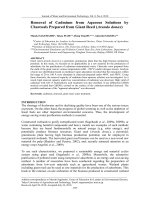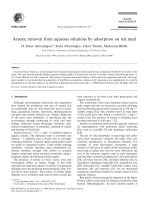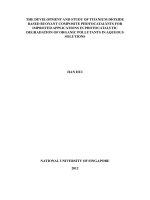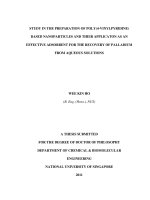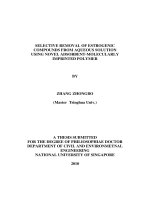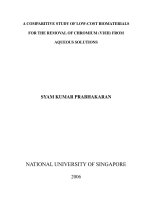Recovery of acetonitrile from aqueous solutions using zeolitic imidazolate framworks
Bạn đang xem bản rút gọn của tài liệu. Xem và tải ngay bản đầy đủ của tài liệu tại đây (2.73 MB, 49 trang )
RECOVERY OF ACETONITRILE FROM AQUEOUS
SOLUTIONS USING ZEOLITIC IMIDAZOLATE
FRAMEWORKS
OH JUN XIAN, DEREK
(B.Eng.(Hons.), NUS)
A THESIS SUBMITTED
FOR THE DEGREE OF MASTER OF ENGINEERING
DEPARTMENT OF CHEMICAL AND BIOMOLECULAR
ENGINEERING
NATIONAL UNIVERSITY OF SINGAPORE
2014
DECLARATION
I hereby declare that the thesis is my original work and it has been
written by me in its entirety. I have duly acknowledged all the sources
of information which have been used in the thesis.
This thesis has also not been submitted for any degree in any
university previously.
1
Acknowledgments
The author would like to extend his gratitude to Associate Professor Jiang Jianwen for his
unending support, valuable assistance and inspirational guidance over the course of this
research, and to the National University of Singapore for having granted the candidate access
to educational and research resources.
2
Contents
1.
Summary .................................................................................................5
2.
List of Tables .......................................................................................... 7
3.
List of Figures ......................................................................................... 7
4.
Introduction ............................................................................................. 8
5.
6.
4.1
Global Acetonitrile Demand and Supply ........................................... 8
4.2
Current Production Methods of Acetonitrile ................................... 10
4.3
Metal-Organic Frameworks ............................................................ 11
4.4
Objectives ...................................................................................... 12
Models and Methods ............................................................................. 13
5.1
ZIFs and Adsorbates ....................................................................... 13
5.2
Simulation Methods........................................................................ 18
Results and Discussion .......................................................................... 20
6.1
Pure Acetonitrile ............................................................................ 20
6.1.1
Adsorption Isotherms .............................................................. 20
6.1.2
Isosteric Heat of Adsorption .................................................... 24
6.1.3
Radial Distribution Functions .................................................. 26
6.1.4
Density Contours ..................................................................... 30
6.2
Pure Water ..................................................................................... 31
6.3
Acetonitrile-Water Mixtures ........................................................... 33
6.3.1
Isotherms and Selectivity ......................................................... 33
3
6.3.2
Density Contours ..................................................................... 36
7.
Conclusions ........................................................................................... 38
8.
Bibliography.......................................................................................... 39
Appendix A .................................................................................................. 45
Appendix B .................................................................................................. 46
Appendix C .................................................................................................. 48
4
1. Summary
Acetonitrile is an important chemical compound and solvent. Many
products ranging from vitamins to antibiotics require it as a starting material
for synthesis. Acetonitrile is usually mixed with water, and used in
pharmaceutical and electrochemical industries, as well as a mobile phase in
liquid chromatography. To recycle and reuse acetonitrile, cost- and energyeffective technology is desired to recover acetonitrile from aqueous solutions.
In the past decade, metal-organic frameworks (MOFs) have emerged as a
new class of nanoporous crystalline materials. They can be synthesized from
enormous metal clusters and organic linkers. The degree of diversity and
multiplicity in MOF structures is substantially more extensive than any other
porous material. With these salient features, MOFs have been considered
versatile materials for diverse potential applications such as storage, separation,
catalysis and drug delivery.
In this study, a sub-class of MOFs namely zeolitic imidazolate frameworks
(ZIFs) are explored by molecular simulation for the adsorptive separation of
acetonitrile from water. Specifically, eight different ZIFs (ZIF-8, 10, 25, 60,
71, 90, 96 and 97) with varying topology and functional group are considered.
At low loading, acetonitrile adsorption is significantly affected by the nature
of ZIF and functional group; at high loading, however, adsorption is mainly
governed by free volume. Water adsorption is much higher in hydrophilic
ZIFs (ZIF-90, -96 and -97) than in hydrophobic counterparts (ZIF-8, -10, -25,
-71 and -60). For acetonitrile/water mixtures, the selectivity of acetonitrile
over water generally drops with increasing composition of acetonitrile.
5
Furthermore, the selectivity is largely related to the hydrophobicity of ZIFs.
Among the eight ZIFs, ZIF-8 exhibits the highest selectivity. The simulation
study provides microscopic insights into the adsorption of acetonitrile and
water in various ZIFs, reveals the significant role of functional groups in
governing adsorption and could facilitate the development of new nanoporous
materials for efficient recovery of acetonitrile from aqueous solutions.
6
2. List of Tables
Table 1. ZIFs and Organic Linkers. .............................................................. 14
Table 2. Structural Properties of SOD- and MER-type ZIFs. ....................... 15
Table 3. Structural Properties of RHO-type ZIFs. ........................................ 15
Table 4. Species Fugacities at different compositions. .................................. 19
Table 5. Atomic Charges of ZIFs. ................................................................ 46
Table 6. DREIDING Force Field Parameters of ZIF atoms........................... 48
Table 7. Potential Parameters of Acetonitrile and Water. .............................. 48
3. List of Figures
Fig. 1 Atomic Structures of ZIF-8, -10, -25, -60, -71, -90, -96 and -97.......... 13
Fig. 2 Simulated ACN Adsorption Isotherms at 298K .................................. 21
Fig. 3 Simulated ACN Adsorption Isotherms at 298K for RHO-type ZIFs. ... 23
Fig. 4 ZIF Isosteric Heats of Adsorption for ACN at infinite dilution at 298K
..................................................................................................................... 25
Fig. 5 Radial Distribution Functions in SOD-type ZIFs ................................ 27
Fig. 6 Radial Distribution Functions in MER-type ZIFs ................................ 28
Fig. 7 Radial Distribution in RHO-type ZIFs ................................................ 29
Fig. 8 Density Contours of ACN in ZIF-8 and ZIF-97 .................................. 31
Fig. 9 Simulated Water Adsorption Isotherms at 298 K ............................... 32
Fig. 10 Density Contours of Water in ZIF-8and ZIF-97 ................................ 33
Fig. 11 Adsorption Isotherms of Binary Solution in ZIF-8, -10, -25, -60, -71,
-90, -96 and -97 at 298K ............................................................................... 34
Fig. 12 Selectivity of ACN-Water mixtures .................................................. 35
Fig. 13 Density Contours of ACN-Water mixtures in ZIF-8 and ZIF-97 ....... 36
7
4. Introduction
4.1 Global Acetonitrile Demand and Supply
Acetonitrile is most notably used as a reagent, reaction solvent or
extraction solvent. Its salient properties such as low UV absorbance, low
pressure and high elution strength, allow for highly sensitive analyses to be
conducted. However, acetonitrile cost has been consistently rising over that of
lower grade solvents such as methanol (Shimadzu Corporation, 2014). With
increasingly strict adherence and compliance to regulatory guidelines being
earmarked by the U.S. Food and Drug Administration (Center for Drug
Evaluation and Research, 2014), more and more companies in the realm of
pharmaceuticals and analytics are thus continuously seeking for cost-effective
and sustainable sources of acetonitrile.
Uses of Acetonitrile
Pharmaceutical industry is the largest end use of acetonitrile. Materials
for which acetonitrile is used as primary feedstock include Vitamins A and B1,
cortisone, carbonate drugs and some amino acids. Acetonitrile is also used as a
solvent for DNA synthesis and production of insulin and antibiotics, one of
which is cephalosporin for the treatment of respiratory tract, skin tissue and
bacterial septicaemia. There has been rapid growth and use of acetonitrile in
recent years as pharmaceutical products for diseases, boosted mainly by
improved living standards in industrialized countries (IHS Chemicals, 2014).
The second-largest use of acetonitrile is as a mobile phase in highperformance liquid chromatography (HPLC). Liquid mixtures of acetonitrile
and water are also frequently employed as mobile phases in reversed-phase
8
HPLC and as solvents in electrochemical applications (van Assche, Remy,
Desmet, Baron, & Denayer, 2011). HPLC has major growth prospects in the
separation of chiral molecules (IHS Chemicals, 2014). Although in the last
couple of years, a shortage of acrylonitrile has motivated some analytical labs
to switch to UPLC (ultra-performance liquid chromatography), this move
comes with significantly higher costs. Thus, acetonitrile demand is still
relatively high and will remain to be so in the years to come (IHS Chemicals,
2014).
Rising Global Consumption of Acetonitrile
Over the last decade, the consumption of acetonitrile has seen strong
growth, at an average annual rate of 5 to 6%. Its world consumption is
forecasted to continue to grow over the next 5 years at a rate of about 6% per
year (IHS Chemicals, 2014).
As a result of a global economic slowdown during 2008 - 2009, there
was a great shortage of acetonitrile – often dubbed The Great Acetonitrile
Shortage. Pharmaceutical companies were then instructed to change and
modify experimental methods to reduce acetonitrile usage. However, since
HPLC analysis methods are bonded by legislation and cannot be easily altered
in the absence of regulatory validation and approval, and thus pharmaceutical
companies were struck particularly hard (van Assche, Remy, Desmet, Baron,
& Denayer, 2011). The consequent peaking of acetonitrile price generated by
this shortage also led to a disruption of acetonitrile demand even till the
middle of 2010 (IHS Chemicals, 2014).
To overcome the aforementioned problems, analytical laboratories and
pharmaceutical producers attempted to use alternative solvents (e.g. methanol)
9
especially in non-sensitive operations such as flushing pipes, cleaning reactors
and other applications. Nevertheless, this reduction in demand has been
largely offset by strong demand growth in China and India, where the highest
growth rate of acetonitrile (around 9 to 10% per annum over the next few
years ending 2020) is forecasted due to the increasing production of
engineered drugs, generic pharmaceuticals and pesticides in these two largest
countries. In Europe, Japan and the United States, the average annual growth
rate over the same period is estimated around 1.5% (IHS Chemicals, 2014).
Acetonitrile Production Statistics
Currently, the producers of acetonitrile are largely segmented. A few
major players account for up to 60% of global capacity, including INEOS in
the United States, Asahi Kasei in Japan and CNPC Jilin Chemical Group in
China. INEOS alone supplies around 40 to 50% of the world’s acetonitrile
(Longden, 2009), amounting to about 34,000 tonnes per annum (Eurasian
Chemical Market International Magazine, 2014). These three companies alone
capture 26%, 20% and 11%, respectively, of the global acetonitrile market
share as well (IHS Chemicals, 2014).
4.2 Current Production Methods of Acetonitrile
The global acetonitrile production is estimated at around 73,500 to
80,000tonnes
annually
(NIIR
Project
Consultancy
Services,
2014).
Acetonitrile is industrially produced primarily via one of three methods, as a
by-product of the SOHIO (Standard Oil of Ohio) propylene ammoxidation
process, from the dehydration of acetamide, and by reacting acetic acid with
ammonia at 400 to 500ºC in the presence of a dehydrated catalyst (National
Centre for Biotechnology Information, 2014).
10
Notably though, apart from solely using the aforementioned methods, enduser companies are currently focussing on and looking for ways to recover and
recycle acetonitrile out of its mixtures with water and/or methanol, to
supplement their acetonitrile needs (van Assche, Remy, Desmet, Baron, &
Denayer, 2011). One such way is through the use of adsorption technology, of
which metal-organic frameworks may be considered suitable candidates.
4.3 Metal-Organic Frameworks
Metal-organic frameworks (henceforth called MOFs) have, within a
period of just over one-two decades, steadily gained ground as novel
nanoporous materials due largely to their unique characteristics and properties
(Evans, 2008). From the myriad of combinations of metal cations and organic
ligands that exist, a large variety of MOFs have been developed with various
pore sizes, offering many research and industrial opportunities (Mueller, et al.,
2006). Today, most experimental and theoretical research of MOFs has
generally been geared towards gas storage and separation (Nalaparaju, Zhao,
& Jiang, 2011). Potential use of MOFs has also been rising in heterogeneous
catalysis (Zou, Abdel-Fattah, Xu, Zhao, & Hickmott, 2010).
A class of MOFs demonstrated promise in the realm of sorption
technology is zeolitic imidazolate frameworks (hence forth called ZIFs),
which contain tetrahedral Zn(II) atoms linked by imidazolate ligands, and their
structures closely resemble zeolitic frameworks (Saint Remy, et al., 2011).
ZIFs have gained considerable attention because of their tuneable porosity,
structural flexibility and functionalization, as well as thermal and chemical
stability (Ortiz, Freitas, Boutin, Fuchs, & Coudert, 2014). For this reason, this
project will focus on the use of ZIFs to meet the project objectives.
11
4.4 Objectives
The advent of The Great Acetonitrile Shortage in 2008 shows the
industrial importance of recovering and recycling expended acetonitrile from
aqueous solutions to circumvent possible future supply disruption from
interfering with essential industrial and laboratory work. The separation of
acetonitrile from aqueous solutions using normal distillation methods
inevitably meets a thermodynamic limit in the form of an azeotropic point at
85.8% acetonitrile (INEOS, 2007), and current separation technologies
involve energy-intensive and/or complex operations such as multiple or
extractive distillation to break this azeotrope (van Assche, Remy, Desmet,
Baron, & Denayer, 2011). This problem is compounded by the fact that
acetonitrile is a very polar amphiphile with a dipole moment about 3.9 D, and
its aqueous solutions are believed to exhibit microheterogeneity (Bakó,
Megyes, Grósz, Pálinkás, & Dore, 2006).
A novel method – inexpensive and not energy-intensive – by which to
purify acetonitrile thus needs to be determined in order to meet the dual goals
of attaining economical solvent consumption and increasing industrial ecofriendliness. This project thus aims to discern the suitability and effectiveness
of several ZIFs in the selective adsorption of acetonitrile from aqueous
solutions through computer simulation, so that these social and economic
objectives might be achieved.
12
5. Models and Methods
5.1 ZIFs and Adsorbates
Fig. 1 illustrates the atomic structures of ZIF-8, -10, -25, -60, -71, -90, -96
and -97. They contain the same tetrahedral ZnN4 clusters, but differ in the
imidazolate linkers as listed in Table 1.
Fig. 1 Atomic Structures of ZIF-8, -10, -25, -60, -71, -90, -96 and -97. ZnN4 cluster:
orange polyhedron, C: grey, O: red, N: light purple, Cl: green, and H: white. The
sizes are not to the same scale.
ZIF-8 and ZIF-90 possess the SOD type topology in which the linker
is singly functionalised at position 2; 4 and 6-membered rings are connected to
form sodalite cages. ZIF-10 and ZIF-60 belong to the MER type topology in
which the linker is not functionalised (except for the meIm linker of ZIF-60
which is functionalised at position 2); 4 and 6-membered rings are connected
to form merlinoite cages.ZIF-25, -71, -96 and -97 belong to the RHO type
with the linker dually functionalised at positions 4 and 5. The 4,6,8-membered
rings are connected to form truncated cuboctohedra (α-cages) in a cubic bodycentred arrangement.
13
Table 1. ZIFs and Organic Linkers.
ZIF
Linker
Shorthand
Label
Chemical
Structure
ZIF-8
2-methyl imidazolate
meIm
C4H6N2
ZIF-10
Imidazolate
Im
C3H4N2
ZIF-25
dimethyl imidazolate
dmeIm
C5H8N2
Imidazolate
Im
C3H4N2
2-methyl imidazolate
meIm
C4H6N2
ZIF-71
dichloro imidazolate
dcIm
C3H2N2Cl2
ZIF-90
imidazole-2carboxyaldehyde
icaIm
C4H4N2O
ZIF-96
cyanide amine imidazolate
cyamIm
C4H4N4
ZIF-97
hydroxymethylmethyl
imidazolate
hymeIm
C5H8N2O
ZIF-60
14
Ball-andStick
Diagram
Table 2. Structural Properties of SOD- and MER-type ZIFs.
ZIF-8
ZIF-90
ZIF-10
ZIF-60
Topology
SOD
SOD
MER
MER
Space Group
I43m
I43m
I43m
I43m
ρa (g cm-3)
0.924
0.988
0.746
0.769
Sa(m2 g-1)
1279
1216
2298
2155
Vf (cm3 g-1)
0.531
0.480
0.819
0.769
Φ
0.491
0.474
0.611
0.589
dc (Å)
11.1
10.4
12.9
12.8
da (Å)
3.1
3.5
7.7
7.7
Linker(s)
a
Densities are based on solvent-free perfect crystals.
Table 3. Structural Properties of RHO-type ZIFs.
ZIF-25
ZIF-71
ZIF-96
ZIF-97
Topology
RHO
RHO
RHO
RHO
Space Group
̅m
Fd3
̅m
Pm3
I432
I432
ρa(g cm-3)
0.949
1.155
0.977
0.997
2
1029
1023
1128
835
Vf (cm g )
0.443
0.447
0.518
0.400
Φ
0.420
0.519
0.505
0.399
dc (Å)
16.2
16.4
16.2
15.8
da (Å)
3.3
3.5
3.8
3.3
Linker
-1
Sa(m g )
3
a
-1
Densities are based on solvent-free perfect crystals.
15
The structural and functional properties of the eight ZIFs are listed in
Table 2 and Table 3. The accessible surface area Sa was estimated using N2 as
a probe with the kinetic diameter of 3.64 Å, while the free volume was
estimated by random insertions of He (a non-adsorbing species). The porosity,
Φ, is defined as the ratio of free volume to framework volume. The pore size
was calculated using the HOLE program, as well as the cage diameter dc and
aperture da.
The framework atoms of the ZIFs were represented by Lennard-Jones (LJ)
and Coulombic potentials:
12
𝑈𝑛𝑜𝑛𝑏𝑜𝑛𝑑𝑒𝑑
𝜎𝑖𝑗
= ∑ 4𝜀𝑖𝑗 [( )
𝑟𝑖𝑗
6
𝜎𝑖𝑗
𝑞𝑖 𝑞𝑗
−( ) ]+ ∑
𝑟𝑖𝑗
4𝜋𝜀0 𝑟𝑖𝑗
Where 𝜀𝑖𝑗 and 𝜎𝑖𝑗 are the well depth and the collision diameter respectively,
𝑟𝑖𝑗 is the distance between atoms i and j, 𝑞𝑖 is the atomic charge of the atom i,
𝜀0 = 8.8524 × 10−12 𝐶 2 ∙ 𝑁 −1 ∙ 𝑚−2 is the permittivity of vacuum.
The atomic charges of the ZIFs were evaluated from the density
functional theory (DFT) calculations based on fragmental clusters (a portion of
each cluster is illustrated in Appendix A). The DFT calculations used the
Becke exchange plus Lee-Yang-Parr functional (B3LYP) and were carried out
using Gaussian 03 (Frisch, et al., 2004). The accuracy of DFT-derived atomic
charges depends on the choice of the functional and basis sets. Expressed as
both local and gradient electron densities, B3LYP has been widely used for
solid materials. For small basis sets, the atomic charges fluctuate appreciably
but tend to converge beyond the 6-31G(d) basis set (Hariharan & Pople, 1972).
Therefore, 6-31G(d) was used for all atoms of the ZIFs except Zn atoms, for
16
which the LANL2DZ basis set – a double-zeta basis set that contains effective
pseudo-potentials to represent the potentials of nuclei and core electrons – was
used. The atomic charges were fitted to the electrostatic potentials and
estimated, as listed in Table 5 of Appendix B. The LJ potential parameters
from the DREIDING force field are listed in Table 6 under Appendix C.
From a number of simulation studies, the DREIDING force field has shown to
be capable of accurately predicting adsorption and diffusion in various MOFs
(Paranthaman, Coudert, & Fuchs, 2010) (Nalaparaju, Zhao, & Jiang, 2010).
ZIF structures were considered to be rigid – valid as a first approximation
since it is known that, for example, the ZIF structures feature some local
flexibility by a ‘‘linker swing’’ motion. However, the importance of flexibility
on adsorption has so far mostly been observed at cryogenic temperatures,
justifying the approximation employed here (Ortiz, Freitas, Boutin, Fuchs, &
Coudert, 2014).
Acetonitrile (CH3-C-N) was represented by a united-atom model with CH3,
C and N taken as single interaction sites. The potential parameters were
adopted from the transferable potentials for the phase equilibria (TraPPE)
force field, which was fitted to measured critical properties and equilibrium
data. Water was mimicked by the three-point transferable interaction potential
model (TIP3P), which reproduces the necessary aspects of water vibration
(Jorgensen, Chandrasekhar, Madura, Impey, & Klein, 1983). In TIP3P model,
the equilibrium O-H bond length is 0.9572Å and the equilibrium bond angle
of H-O-H is 104.52°. The TIP3P gives reasonably good interaction energy
compared to experiments (Jorgensen, Chandrasekhar, Madura, Impey, & Klein,
1983). Table 7 in Appendix C gives the potential parameters of acetonitrile
17
and water, and the cross interactional parameters were estimated using the
Lorentz-Berthelot combining rules.
5.2 Simulation Methods
To simulate the adsorption of pure acetonitrile and water as well as their
mixtures, grand canonical Monte Carlo (GCMC) method was used. The
chemical potentials of an adsorbate in the adsorbed and bulk phases are
identical at thermodynamic equilibrium, and the GCMC method allows one to
directly relate the chemical potentials in both phases and has been widely used
to simulate adsorption (Nalaparaju, Zhao, & Jiang, 2010). For pure acetonitrile
and water, the adsorption was simulated below and up to saturation pressures
(11.71 kPa and 3.18 kPa respectively), and thus there were considered as ideal
gases. The simulation boxes contained the ZIFs and the periodic boundary
conditions were extended in three directions. For acetonitrile-water liquid
mixtures, the fugacities were estimated by:
𝑓𝑖 =
̅̅̅̅
𝑉𝑖 (𝑃−𝑃𝑠𝑎𝑡
𝑖 )
)
𝑅𝑇
(
𝑓𝑒𝑒𝑑
𝑃𝑖𝑠𝑎𝑡 𝜑𝑖𝑠𝑎𝑡 𝑥𝑖
𝛾𝑖 𝑒
where 𝑃𝑖𝑠𝑎𝑡 refers to the saturation pressure of species I estimated by The
𝑓𝑒𝑒𝑑
Antoine equation, 𝜑𝑖𝑠𝑎𝑡 the fugacity coefficient of species i, 𝑥𝑖
the mole
fraction of species i in the liquid phase, 𝛾𝑖 the activity coefficient of species i
estimated from the Non-Random Two Liquid (NRTL) excess Gibbs energy
̅𝑖 the partial molar volume of species i, and 𝑃 the operating pressure.
model, 𝑉
Under the operating conditions (1 bar and 298K) considered in this study, the
fugacity coefficient and Poynting factor are approximately equal to unity. The
fugacity values were varied for the composition range between xw = 0.1 to
0.97, as shown in Table 4.
18
Table 4. Species Fugacities at different compositions.
xw
fwater (kPa)
facetonitrile (kPa)
0.1
0.314
10.539
0.2
0.628
9.368
0.3
0.942
8.197
0.4
1.256
7.026
0.5
1.570
5.855
0.6
1.884
4.684
0.7
2.198
3.513
0.8
2.512
2.342
0.9
2.826
1.171
0.93
2.920
0.820
0.95
2.983
0.586
0.97
3.046
0.351
In the GCMC simulations, the LJ interactions were evaluated with a
spherical cut-off of 15 Å. For the Coulombic interactions, the Ewald sum with
a tin-foil boundary condition was used. The real/reciprocal space partition
parameter and the cut-off for reciprocal lattice vectors were chosen to be 0.2
Å-1 and 8, respectively, to ensure the convergence of the Ewald sum. The
number of trial moves in a typical GCMC simulation was 2 × 107 (20000 MC
cycles, 1000 moves per cycle) for pure water and acetonitrile, and 4 × 107
(20000 MC cycles, 2000 moves per cycle) for binary mixtures. In both cases,
the first half of trial moves employed was used for equilibration and the
second half for ensemble averages. Five types of trial moves were randomly
attempted, namely displacement, rotation, partial regrowth at a neighbouring
position, complete regrowth at a new position, and a swap between reservoirs
including creation and deletion with equal probability. To improve sampling
efficiency, a configurational-bias technique was adopted in which an adsorbate
19
molecule was grown atom-by-atom biasing towards energetically favourable
configurations while avoiding overlap with other atoms (Frenkel, Mooij, &
Smit, 1992) (de Pablo, Laso, & Suter, 1992) (Siepmann & Frenkel, 1992).
Specifically, the trial positions were generated with a probability proportional
𝑖
𝑖
) , where 𝛽 = 1/𝑘𝐵 𝑇 and 𝑈𝑖𝑛𝑡𝑟𝑎
to 𝑒𝑥𝑝(−𝛽𝑈𝑖𝑛𝑡𝑟𝑎
is the intramolecular
interaction energy at position i. The numbers of trial positions for the first and
subsequent atoms were, respectively, ten and fifteen for acetonitrile and water.
One of the trial positions was then chosen with a probability proportional
𝑖
𝑖
𝑖
)⁄∑𝑖 𝑒𝑥𝑝(−𝛽𝑈𝑖𝑛𝑡𝑒𝑟
) , where 𝑈𝑖𝑛𝑡𝑒𝑟
to 𝑒𝑥𝑝(−𝛽𝑈𝑖𝑛𝑡𝑒𝑟
is the intermolecular
interaction energy.
6. Results and Discussion
First, the adsorption properties of pure acetonitrile in the eight ZIFs are
presented. From adsorption isotherms, isosteric heats, and radial distribution
functions, the role of functional groups is quantitatively assessed. Then, the
adsorption of pure water is discussed. Finally, the separation of acetonitrilewater mixtures is examined and the highest selectivity is identified.
6.1 Pure Acetonitrile
6.1.1 Adsorption Isotherms
Fig. 2 shows the adsorption isotherms of pure acetonitrile in the ZIFs
studied at 298K and various pressures up to the normal saturation pressure of
acetonitrile (11.71 kPa). It has to be noted that currently experimental data for
acetonitrile adsorption in ZIFs are not available, and the reader is kindly
advised to exercise discretion when using the results of this study. The general
20
features of adsorption are well captured by the simulation. With increasing
pressure, the isotherms can be characterised into two categories based on the
hydrophobicity/hydrophilicity of the ZIFs. Furthermore, the different
structural properties also contribute to the varying ZIF adsorption performance.
Fig. 2 Simulated Acetonitrile Adsorption Isotherms at 298K. The unit of the ordinate
is mmol per gramZIF. Low-pressure range is depicted in the inset.
In the low-pressure region (e.g. where relative pressure is about 0.001),
uptake decreases in the order of ZIF-97 > -96 > -90 > -71 > -25 > -8 ≈ -10 ≈ 60. This apparently shows the effect of the functional groups on molecular
interactions. Acetonitrile is a well-known polar aprotic solvent and possesses
two sites for accepting a hydrogen bond: one on the lone-pair electrons of the
nitrogen atom (σ bonding) and the other on the C≡N bond (π bonding)
(Kyrachko & Nguyen, 2002). ZIF-97, -96 and -90 all contain polar groups and
21
can form strong bonds with acetonitrile. In contrast, the functional groups in
ZIF-8, -10, -25, -60 and -71 are only non-polar (–CH3) or weakly-polar (–Cl)
and therefore, interact weakly with acetonitrile. ZIF-25 and -71 have slightly
higher uptakes as compared to the other hydrophobic ZIFs as they contain
doubly-functionalised linkers, and thus the scope for interaction with
adsorbate is increased.
In the high-pressure region, functionality is not the only factor that
affects adsorption and saturation capacity; the free volume 𝑉𝑓 (and to a certain
extent, the porosity Φ) becomes increasingly important. This factor is
enhanced due to the fact that acetonitrile is an exceptionally small molecule
(about 3.5 Å in length) and thus has a high degree of mobility (Kyrachko &
Nguyen, 2002).
With the same SOD topology, ZIF-8 has a larger free volume than
ZIF-90 and thus a higher saturation uptake. The adsorption is also observed to
be governed by the hydrophilicity/hydrophobicity of the ZIFs. ZIF-90 adsorbs
acetonitrile over the whole range of pressures given the existence of the polar
–CHO carboxyaldehyde group, whilst ZIF-8 exhibits a sudden drastic step in
uptake at the relative pressure > 0.01 due to the cage filling mechanism.
In the MER-type ZIFs (ZIF-10 and -60), both contain non-polar groups,
their adsorption isotherms behave exactly like that in ZIF-8, but this time
exhibiting a drastic step around the region where relative pressure is 0.02. This
can also be explained by the cage filling mechanism. With a larger free
volume than ZIF-60, ZIF-10 attains a higher saturation uptake.
22
Fig. 3 Simulated Acetonitrile Adsorption Isotherms at 298K for RHO-type ZIFs. The
unit of the ordinate is mmol per cm3 ZIF.
However, in the RHO-type ZIFs, the effect of free volume is not as
dominant. The free volumes of the RHO-type ZIFs decrease in the order ZIF96 > -71 > -25 > -97, and we observe that the maximal saturation level in ZIF96, which has the largest free volume by-and-large, is the highest; the other
RHO-type ZIFs exhibit lower maximal saturation values. Yet, the maximal
uptake values on basis mmol per unit mass of ZIF (ZIF-96 > -97 ≈ -25 > -71)
do not follow the free volume trend; and the explanation becomes clearer
when ZIF densities are taken into account.
By changing the basis with which the adsorption values are measured,
from mmol per unit mass to mmol per unit volume of ZIF, as shown in Fig. 3,
23
the trend in acetonitrile uptake of the RHO-type ZIFs can be better discerned.
In effect, this change of basis allows for comparison to be based on porosity,
which is of the order ZIF-71 > -25 > -97. From Fig. 3, it is seen that the
maximal uptakes for these three ZIFs are of the order ZIF-71 > -97 > -25, with
ZIF-97 deviating from the trend of decreasing porosity. The reason for ZIF-97
exhibiting higher saturation uptake than ZIF-25, despite a slightly lower
porosity and free volume, is due to its polar functional group (–CH2OH)
allowing for stronger attractive interactions to draw and retain adsorbate as
compared to the non-polar methyl group (–CH3) in ZIF-25. Thus we can
conclude that in this case, acetonitrile adsorption in the RHO-type ZIFs is
affected by a combination of all three factors – linker functionality, free
volume and porosity.
6.1.2 Isosteric Heat of Adsorption
To quantitatively examine adsorption energy, the isosteric heat of
0
adsorption𝑄𝑠𝑡 was investigated as a function of loading. Specifically, 𝑄𝑠𝑡
at
infinite dilution was estimated by a single-molecule Monte Carlo simulation:
0
0
𝑄𝑠𝑡
= 𝑅𝑔 𝑇 − 𝑈𝑎𝑑
0
𝑈𝑎𝑑
= 𝑈𝑡𝑜𝑡𝑎𝑙 − (𝑈𝑎𝑑𝑠𝑜𝑟𝑏𝑒𝑛𝑡 − 𝑈𝑎𝑑𝑠𝑜𝑟𝑏𝑎𝑡𝑒 )
where 𝑅𝑔 is the universal gas constant, 𝑇 is the temperature, 𝑈𝑡𝑜𝑡𝑎𝑙 , 𝑈𝑎𝑑𝑠𝑜𝑟𝑏𝑒𝑛𝑡
and 𝑈𝑎𝑑𝑠𝑜𝑟𝑏𝑎𝑡𝑒 are the potential energies of the adsorbent-adsorbate, adsorbent
and a single adsorbate molecule, respectively. The conformational change in
the adsorbate upon adsorption was taken into account. At finite loadings, 𝑄𝑠𝑡
was estimated using:
24
